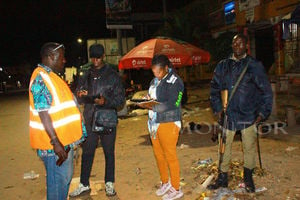Kampala City road repairs: An update

Mr Simon P. Kasyate
What you need to know:
- Budget available, KCCA shall remain relentless in its maintenance role.
Kampala City has a total road network of 2100km. Of these, only less than 700km are paved (covered with tarmac/asphalt); the rest (about 1,500km) are murram or dust tracks.
In the last two months, there was cry and hue over the state of the city roads; where driving in Kampala could only best be described wittingly as “We do not drive on the left, but rather on what’s left of our roads.” Potholes riddled sections of the city roads that driving in a straight line, on what’s ordinarily a straight road was a preserve of the inebriated – those were the jokes that made rounds in real talk and on social media.
There is no doubt that there is immaculately paved roads complete with the attendant road furniture like street lighting, signalised junctions, lane paints, reflectors and barriers compete with pedestrian and cycle lanes.
On Mutungo Hill for example, the ringroad, Natasha road and that trans-hill road from Spring road down to the Biina church junction among others remain a welcoming allure to residents and commuters in that area, not to mention the access road into Luzira from the ‘backside’.
In Ntinda and Naguru, in roads connecting Stretcher to the Bukoto-Ntinda main roads have seen major rehabilitation. The same can be said of places in Rubaga Division like Kituuzi Lungujja and other adjoining areas.
But all these beautifully made roads pale in comparison to major artery roads like the Industrial area pack of 5th, 6th, 7th and 8th streets; Salaama road, Sir Apollo Kaggwa and Old Potbell road which have gone past their ‘sale by dates’.
The good news is that, the Kampala City roads Rehabilitation project, financed by the African Development Bank is now underway and works have begun on the majority of these roads.
What was sticking out like a sore thumb were the potholes on these and other roads that made city commute a hellish adventure. This was exacerbated by the lack of adequate financing to KCCA for routine repairs as it were. By December 2022, KCCA had identified an area of 8,500 square metres of potholes, spread across the five divisions and had a repair plan in place. The plan could not be actuated due to lack of funding.
As at start of this month, 6,000 square metres of these have since been prepared, filled and covered with asphalt; while more work continues to be done by our division maintenance teams.
In Nakawa , more than 20 roads have had repairs, making a total of 1579.8 square metres. In Makindye Division, over 20 roads have had repairs, making a total of 1288.73 square metres.
In Central region, more than 30 roads have had repairs, making a total of 1038 square metres. Kawempe Division, of the 972 square metres of potholes lined up for repair, 977 have been completed accounting for over 100 percent execution on roads.
A lot of work remains to be done and KCCA is awake to the fact that roads repairs is not a ‘one off’ activity but a going concern. Budget available, KCCA shall remain relentless in its maintenance role while also keeping a hawk’s eye supervision over the rehabilitation projects currently going on in the city.
There are four major drainage works currently on going using GoU funds. Under World Bank funding, drainage improvement works on Lubigi Primary channel and Nakamiro Secondary channel in Kawempe Division are almost complete. There is also marked progress in the construction of the traffic centre under the Uganda-Japan technical cooperation project named “The Project for Capacity Enhancement of KCCA in Management of Traffic Flow in Kampala City.
These almost simultaneously happening construction and routine maintenance activities portend great disruption and in a few months, we shall need to plan our routes and times with this consideration in mind especially as the third term school commutes get underway.
Simon Kasyate is the Kampala Capital City Authority (KCCA) deputy director of public & corporate affairs




